
94% of researchers rate our articles as excellent or good
Learn more about the work of our research integrity team to safeguard the quality of each article we publish.
Find out more
ORIGINAL RESEARCH article
Front. Sustain. Food Syst., 06 October 2022
Sec. Agroecology and Ecosystem Services
Volume 6 - 2022 | https://doi.org/10.3389/fsufs.2022.995224
This article is part of the Research TopicContinuous Living Cover: Adaptive Strategies for Putting Regenerative Agriculture into PracticeView all 23 articles
Living mulch systems can provide multiple agronomic and ecosystem benefits, including reducing erosion and decreasing weed and pest pressure. However, inconsistent yields and lack of best practices for weed and pest management have contributed to their lack of adoption by farmers. In 2018 and 2019, living mulch practices for organic zucchini (Cucurbita pepo L.) production were assessed in Wisconsin on certified organic land. Living mulches of Dutch white clover (Trifolium repens), annual ryegrass (Lolium multiflorum), and a mix of Dutch white clover and annual ryegrass were compared with full tillage cultivated ground and straw mulch controls for effect on yield, fruit marketability, weed and pest counts, and weed management time. Mixed species living mulch, cultivated, and straw mulch treatments were consistently higher yielding than clover treatments, while ryegrass had variable results. No differences were observed in the number of squash bug (Anasa tristis) egg clusters per plant across mulch treatments, but clover treatments had fewer adult squash bugs, with ryegrass and mixed species living mulches also trending lower. Lower counts of striped cucumber beetles (Acalymma trivittatum) were also observed in living mulch treatments. Ryegrass and mixed species living mulches were generally more weed suppressive than clover and cultivated aisles, although living mulch treatments generally had more weeds than straw mulched aisles, apart from comparable suppression of grass weeds for ryegrass in 2019. Time required for weed management was greater for the living mulch treatments than straw, while cultivated treatments took longer to manage than all other treatments in 2019 and longer than ryegrass and straw in 2018. Despite higher weed counts in clover than in cultivated aisles in 2019, all living mulches required less time for weed management than cultivation, indicating that managing living mulches with mowing can be more efficient than hand cultivation, even with higher weed counts. Our results support previous evidence that certain living mulch species may reduce pest and weed pressure, but also reinforces that living mulch systems can negatively impact yield depending on species selection and environment.
Weed management is a critical challenge facing organic farmers and is consistently cited as a priority for further research (Moynihan, 2010; Jenkins and Ory, 2016). To manage weeds in vegetable crops, organic growers rely heavily on both mechanical cultivation and plastic mulches (Jabbour et al., 2016; Brown and Gallandt, 2018). Plastic mulches can be used to prevent weed emergence within the planting row where mechanical and hand weeding may be difficult once the crop establishes. In addition to their weed suppressive benefits, plastic mulches provide other positive aspects to the production systems, including increased soil temperature and moisture retention, which often contributes to higher yield (Kasirajan and Ngouajio, 2012; Steinmetz et al., 2016). However, plastic mulch systems also present management challenges, including exacerbation of erosion due to water runoff into the aisles between beds, which are usually managed as bare soil with cultivation or herbicide (Arnold et al., 2004; Rice et al., 2004).
Environmental impacts of runoff and erosion can be mitigated in plastic mulch systems by planting living cover crops between the plastic-covered beds (Arnold et al., 2004). The use of cover crops between rows can also reduce the long term weed seedbank while providing additional ecological services (Liebman et al., 1997; Baraibar et al., 2018; Wauters et al., 2021). Cover crops can suppress weeds through direct competition (Hiltbrunner et al., 2007; Bezuidenhout et al., 2012; Brust et al., 2014) and by generating residues which can suppress weed emergence through physical (mulch) effects, release of allelochemicals, and changes in nutrient dynamics (Teasdale and Mohler, 2000; Sarrantonio and Gallandt, 2003; Teasdale et al., 2012). Full season cover crops utilized as living mulches may also have benefits unique as compared to terminated cover crop mulches, such as promoting arbuscular mycorrhizal colonization and enhancing nutrient uptake (Deguchi et al., 2012).
While cover crops are used extensively in organic production (USDA-NASS, 2019), they are typically terminated and incorporated prior to planting the cash crop (Magdoff and Van Es, 2000). Shorter growing seasons in temperate climates, coupled with diverse, complex, and high value rotations on vegetable farms, further complicate integration of cover crops into tillage-intensive production systems of cucurbit growers in cooler climates (Sarrantonio, 1992; Snapp et al., 2005). The use of living mulches between plastic-mulched beds provides an opportunity to integrate cover crops into vegetable systems, as the cash crop can be grown concurrently with a full season cover crop while maintaining the benefits of the plastic mulch within a targeted planting zone (Tarrant et al., 2020).
Adoption of living mulch-based reduced tillage vegetable systems has been limited partly because of variable or negative effects on yield (Law et al., 2006; Butler et al., 2013; Reid and Klotzbach, 2013; Warren et al., 2015; Hinds et al., 2016; Pfeiffer et al., 2016), although other studies have shown positive results (e.g., Sportelli et al., 2022). The unique interactions of each cash crop and cover crop contributes to the variability in observed results, creating challenges in the development of robust best practices for the diversity of crops produced by organic vegetable growers (Walters et al., 2011; Brainard et al., 2013). Living mulch studies focused on cucurbit production have shown inconsistent impacts on yields, with some indicating potential for equivalent or higher yields (Nelson and Gleason, 2018; Kahl et al., 2019) and others showing negative or variable impacts (Nyoike and Liburd, 2010; Hinds et al., 2016).
Choice of living mulch species is important to maximize weed control benefits of living mulches while minimizing risks associated with competition (Tarrant et al., 2020). Clovers are a common choice as their ability to fix atmospheric N provides fertility benefits and reduces the risk of N competition with the cash crop (Hartwig and Ammon, 2002). However, clovers also tend to be slower growing and less competitive against summer annual weeds (MacLaren et al., 2019). Tarrant et al. tested nine living mulch species and combinations and found that all living mulch treatments reduced weed biomass, with weed biomass negatively correlated with living mulch biomass. In addition, Tarrant et al. found that all treatments had the potential to compete with cash crops by lowering soil inorganic nitrogen and moisture levels within the plastic mulched beds (Tarrant et al., 2020). However, specific management such as root pruning, which reduces the depth and biomass of living roots, may reduce potential for competition (Båth et al., 2008). The drastic removal of above ground biomass caused by mowing may be associated with corresponding reductions in root biomass, and thus reduce competition potential (Liu and Huang, 2002). For instance, Hinds et al. (2016) found that zucchini yields were reduced in a living mulch system with sunn hemp (Crotalaria juncea L.) grown to a height of 45 cm, but when the sunn hemp was managed to a height of 20 cm, zucchini yields were equivalent or greater in the living mulch treatment than bare ground.
Mulch choice can also affect pest pressure. Two major pests of cucurbits in the upper Midwestern USA include striped cucumber beetle (Acalymma trivittatum) and squash bug (Anasa tristis). As chemical control options for organic growers are limited, organic growers must integrate cultural and mechanical methods, such as rotation, exclusion, and intercropping, in addition to allowable chemical controls to both effectively manage pest pressure and mitigate the risk of insecticide resistance (Doughty et al., 2016; Haber et al., 2021).
Some studies have shown that living mulch can exacerbate pest issues (Reid and Klotzbach, 2013), while others have shown variable or beneficial effects on pest levels (Amirault and Caldwell, 1998; Nyoike and Liburd, 2010; Grasswitz, 2013; Hinds et al., 2016). For instance, Kahl et al. (2019) found that cucumber (Cucumis sativus L.) interplanted with red clover (Trifolium pratense L.) had increased counts of natural enemies and lower counts of cucumber beetles and reduced melon aphid (Aphis gossypii) pressure, although spotted cucumber beetle (Diabrotica undecimpunctata howardi) had a variable response. Grasswitz (2013) found a similar negative response to interplanting for cucumber beetles, but saw no effect on squash bug presence, while Nyoike and Liburd (2010) also found increased natural predator populations in a buckwheat (Fagopyrum esculentum Moench) living mulch.
This study expands on previous research on living mulches in a plasticulture system. We specifically evaluate the effects of cover crop living aisles [Dutch white clover (Trifolium repens), annual ryegrass (Lolium multiflorum), and a mix of Dutch white clover and annual ryegrass] as compared to control treatments (cultivated management and straw mulch) on organic zucchini fruit yield, weed and pest pressure, and weed management time. We tested the null hypotheses that there would be no effect from aisle mulch in explaining yield, plant survival, or percent cover. We also tested the null hypothesis that there would be no significant effect from or interaction between aisle and date on weed counts, pest counts, or weed management time, which would indicate that the mulch treatments performed the same throughout the season.
Field trials were conducted at the University of Wisconsin West Madison Agricultural Research Station on Batavia and Troxel Silt Loams in 2018 and 2019. Two areas of certified organic land (43.0734, −89.5474, and 43.0744, −89.5465) were used for the experiment (following the termination of a third-year alfalfa stand) and managed in accordance with the United States Department of Agriculture National Organic Program (USDA-NOP) regulations (National Organic Program, 2000). Soil organic matter was 3.3% in 2018 and 2.9% in 2019, and pH was 6.6 in 2018 and 7.2 in 2019. The experiment was established as a randomized complete block design with four replications, one row per replication, additional guard rows in between data rows to separate living mulch treatments (for a total of 9 rows), and 8 plants per plot at 0.61 m in-row and 2.44 m between-row spacing. Thus, each plot was 5.49 m long by 2.44 m wide (Supplementary Figure 1). Aisle mulch treatments included a cultivated control, ground straw mulch at a rate of ~31 T ha−1, Dutch white clover seeded at a rate of 24.64 kg ha−1, and annual ryegrass, seeded at a rate of 101.66 kg ha−1, as well as a mix of the two seeded at a rate of 15.57 kg ha−1 Dutch white clover and 31.37 kg ha−1 annual ryegrass.
Field activities are summarized in Table 1. Cereal rye (Secale cereale) rye was seeded throughout the entire study area with a Landoll grain drill (Landoll Corporation, Marysville, KS) at a rate of 127 kg ha−1 on September 25, 2017 and September 27, 2018, 2–3 weeks following the termination of a third-year alfalfa stand with a Brillion Super Soil Builder Disk Chisel (Brillion Iron Works, Brillion, WI). The following spring, rye was terminated through tillage with a Case IH JX65 tractor with 65 horsepower (Case IH, Racine, WI) with a PTO driven Land Pride RTA3576 tiller with a 1.83 m working width (Land Pride, Salinas, KS). One tillage event was adequate to terminate the rye in 2018, but a second tillage event was required in 2019. Fertilizer was broadcast applied according to University of Wisconsin-Madison Division of Extension recommendations (Laboski and Peters, 2019) based on soil test results, and was incorporated with an additional rototilling. Plastic mulch (1.22 m wide) and drip irrigation was applied in planting strips with a Mechanical Transplanter Model 85 mulch layer (Mechanical Transplanter Company, Holland, MI), ground winter wheat straw mulch was applied by hand for check plots and living mulch treatments were seeded by hand and lightly incorporated by raking. Three-week-old “Dunja F1” zucchini summer squash (Cucurbita pepo) transplants grown in 50 cell trays were hand transplanted. Drip irrigation placed under the mulch was applied as needed throughout the season.
Weeds were categorized as broadleaf or grass weeds and counted within four randomly placed 0.25 m2 quadrats (two each side of the data row, n = 16 per treatment at each date) within 24 h prior to timed manual weeding. Weeds were removed manually within the ground straw treatment and with stirrup hoes supplemented by additional hand weeding on the shoulders of beds to avoid tearing plastic within the cultivated treatment. Living mulch treatments were managed by mowing with a Simplicity 13.5 hp walk-behind brush hog (Simplicity Manufacturing, Port Washington, WI) with a 15 cm blade height, supplemented by additional hand weeding to avoid weeds reaching reproductive maturity. Total weeding time (for a single person) required for weed management after the planting of the cash crops was recorded separately for each treatment at each weeding event (n = 4 per treatment at each date). Weeding data was taken either when weed pressure necessitated weeding, as determined by weeds approaching flowering or being above 30 cm, or when ryegrass or mixed species living mulches needed mowing, as determined by ryegrass being above 30 cm. Cucumber beetle, squash bug egg clusters, and adult squash bugs per plant were counted as close to a weekly basis as possible (n = 32 per treatment at each date), but were reported as per m of row for easier translation to field scales, with 1.64 plants per m.
Squash was harvested when fruit had reached marketable maturity at >15 cm, averaging every 6 days in 2018 and every 2.5 days in 2019. In each plot, the plant stand count was recorded and all squash of adequate size were harvested and sorted by quality as marketable or non-marketable. Fruit was counted as unmarketable if it showed visible evidence of rot, insect damage, surface blemishes, or was misshapen. Fruit was counted as marketable if firm and had smooth, unblemished skins. Due to early season squash bug pressure in 2019, pyrethrin (PyGanic®,Sumitomo Chemical, Chuo City, Tokyo, Japan) was applied once on July 31.
Data was analyzed in R [R.app GUI 1.4 “Juliet Rose” (df86b69e, 2021-05-24), © R Foundation for Statistical Computing, 2021]. Analysis of Variance (ANOVA) for data such as yield, marketability, survival, weed management time, and pest counts were done using the lme() function in the “nlme” package (Pinheiro et al., 2022) using the following model:
where Yijkl is the observation for the ith year, jth block, and kth aisle mulch treatment, Ai is the fixed effect of the ith year (i = 2018, 2019), Bj(i) is the random effect of the jth block nested within the ith year (j = 1, 2, 3), Mk is the fixed effect of the kth aisle mulch treatment (k = cultivated, straw, clover, ryegrass, or mix), (AM)ik is the effect of the interaction between the ith year and kth aisle mulch and ϵijk is the residual error associated with the observation for the ith year, jth block, and kth aisle mulch treatment.
Pest counts, harvest counts, and weed management time were transformed to cumulative counts per plot, with only the final cumulative count analyzed to meet assumptions of independent observations and improve assumptions of normality and equality of variance due to the large amount of zeros in the raw data. Use of cumulative counts and time was also chosen because the focus was on the cumulative impact of pests and weed management time, and total harvest potential in relation to mulching strategy, rather than prevalence of pests, weed management time, and harvest over time in relation to informing management decisions during the season. Analysis for weed counts included an additional subsampling error term γm(kjil) which was the random effect of the mth subsample where m = 1, 2, 3, 4 subsamples for weed counts. Since survival rate was not associated with aisle mulch treatment yield m−1 analyses also included a covariate of stand count, βXijk where β is the slope of the covariate of stand count X within the ith year, jth block, and kth aisle mulch treatment.
Normality and equality of variances were checked visually with standardized residuals vs. fitted value plots and normal QQ plots, respectively, (R Core Team, 2022). Right skewed weed count data for each ANOVA for a given dependent were transformed with log(x + 1) when necessary to improve assumptions of normality and equality of variances. When ANOVA F-tests were significant, Tukey's Multiple Comparison Procedure was used to compare treatment means and develop significance groupings using the emmeans() function in the “emmeans” package (Lenth, 2022), which is also how estimated marginal means for tables were obtained. When two-way interactions between main effects were found, pairwise comparisons for the simple main effect were made for each level of the other factor, again using the emmeans() function with a Tukey adjustment. All figures are shown with non-transformed data though significance groupings are based on transformed data when applicable.
The winter and spring months leading into the 2018 growing season experienced slightly more precipitation than average and close to average temperatures with the accumulation of more growing degree day units (GDDU) than normal, providing an environment conducive to greater cereal rye biomass accumulation as compared to 2019, which experienced a particularly cold, wet winter and a cool, dry spring (Table 2). Both 2018 and 2019 experienced more rainfall than average, with a single rain event in late August of 2018 releasing over 25 cm of rain within 24 h at the study site (MRCC, 2021).
Average survival rates across both years ranged between 81% for straw mulch and 92% mixed species living mulch treatments, but was not significantly impacted by aisle mulch treatment, year, or an interaction between the two (Table 3).
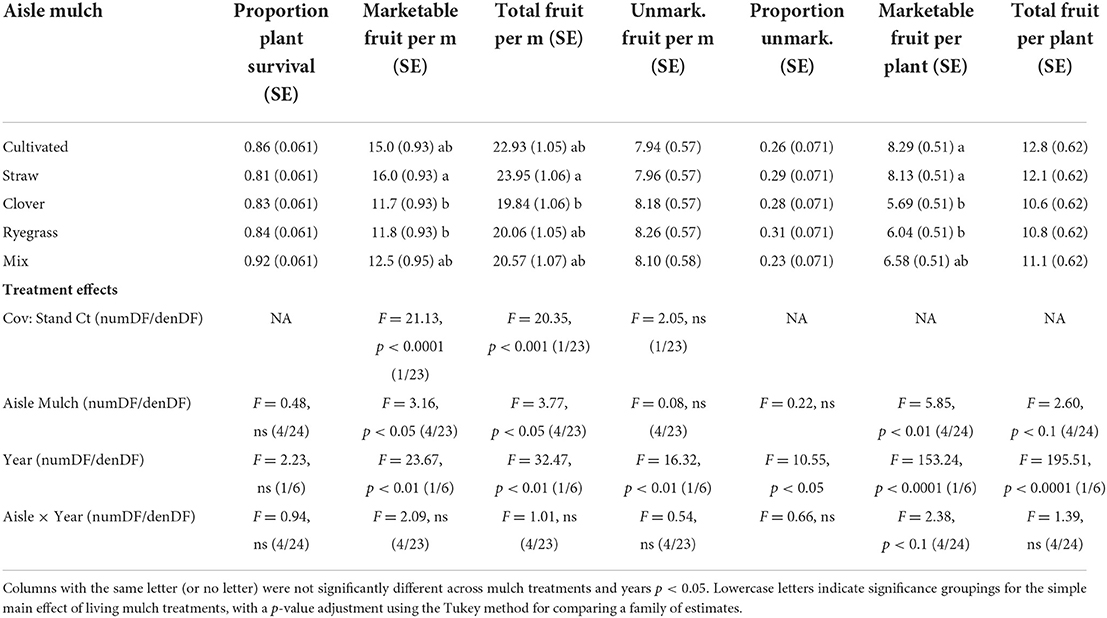
Table 3. Cumulative yield, fruit quality, and survival data of organic zucchini by living mulch treatment.
Because variation in the proportion of plants that survived was observed which would affect yield m−1, but aisle mulch treatments themselves did not affect this proportion, the proportion of plants surviving was used as a covariate, which had a significant effect on both cumulative marketable fruit and total fruit, but not on unmarketable fruit.
Year influenced all yield response variables. Aisle mulch affected marketable and total fruit m−1 but did not affect unmarketable fruit counts m−1 or the proportion of fruit that were unmarketable (Figure 1). Aisle mulch was also significant for marketable fruit plant−1 but not total fruit plant−1 (Supplementary Figure 2). Both fruit m−1 and fruit plant−1 were analyzed since the surviving plant population ranged from 50 to 100% survival. On a m−1 basis, straw mulch treatments out yielded clover treatments for both marketable and total fruit, and the ryegrass treatment for marketable fruit. On a plant−1 basis, both the straw mulch and cultivated treatments yielded more marketable fruit than clover or ryegrass treatments, while the mixed species living mulch treatment was similar to both groups.
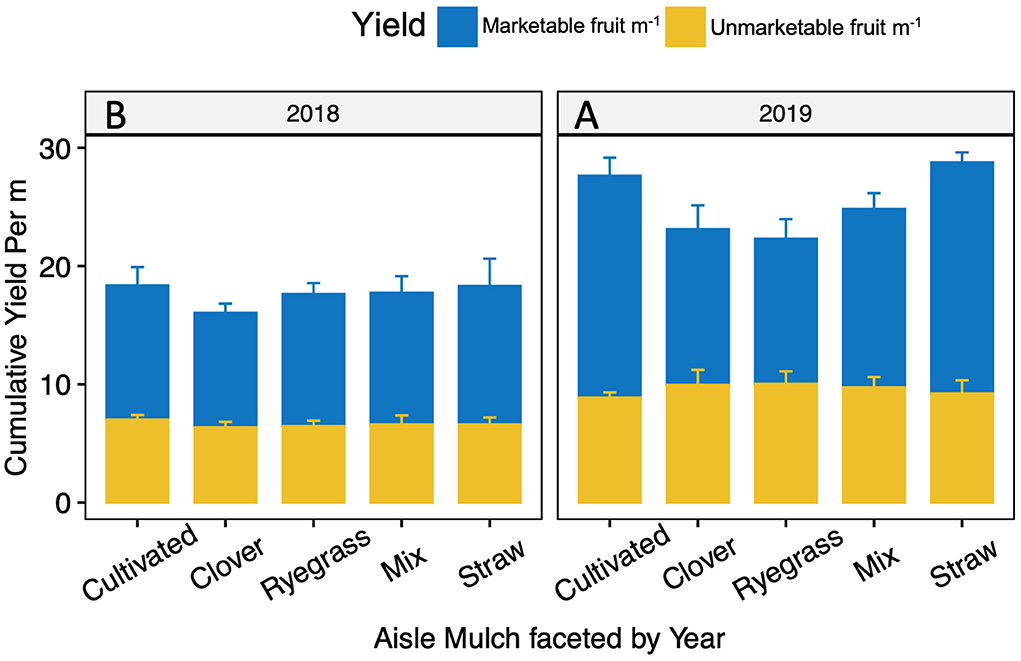
Figure 1. Yield of marketable and unmarketable fruit m−1 of organic zucchini grown using cover crop living mulches, 2018 and 2019. Uppercase letters indicate groupings for year across mulch treatments year at p < 0.05.
There was a significant year × mulch interaction for cumulative number of cucumber beetles m−1 (Table 4). Although cucumber beetle pressure was negligible in 2018 and there were no differences between treatments, clear differences were evident during the 2019 season. Cultivated and straw mulch treatments resulted in higher cucumber beetle counts m−1 than the clover or ryegrass treatments, while the mixed species living mulch treatment resulted in lower cucumber beetle counts as compared with the straw mulch treatment but was not different from other living mulch treatments (Figure 2). The cumulative number of squash bug egg clusters m−1 was not affected by aisle mulch, although more egg clusters were observed in 2019 as compared to 2018 (Figure 3). In contrast, the number of adult squash bugs m−1 was affected by aisle mulch but not year (Figure 4), with clover having lower counts as compared to straw or cultivated treatments. Both ryegrass and mixed species cover crop treatments were not different from either group.
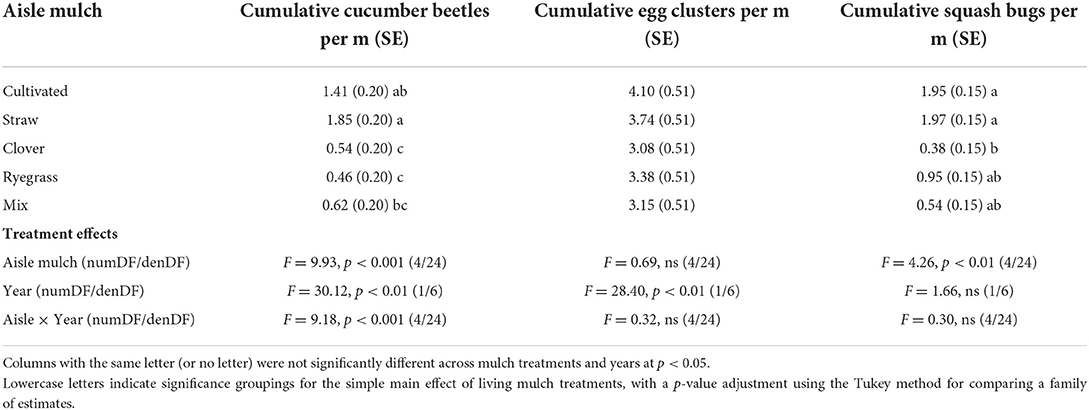
Table 4. Final cumulative counts of striped cucumber beetle, squash bugs and egg clusters in 2018 and 2019 on organic zucchini plants by living mulch treatment.
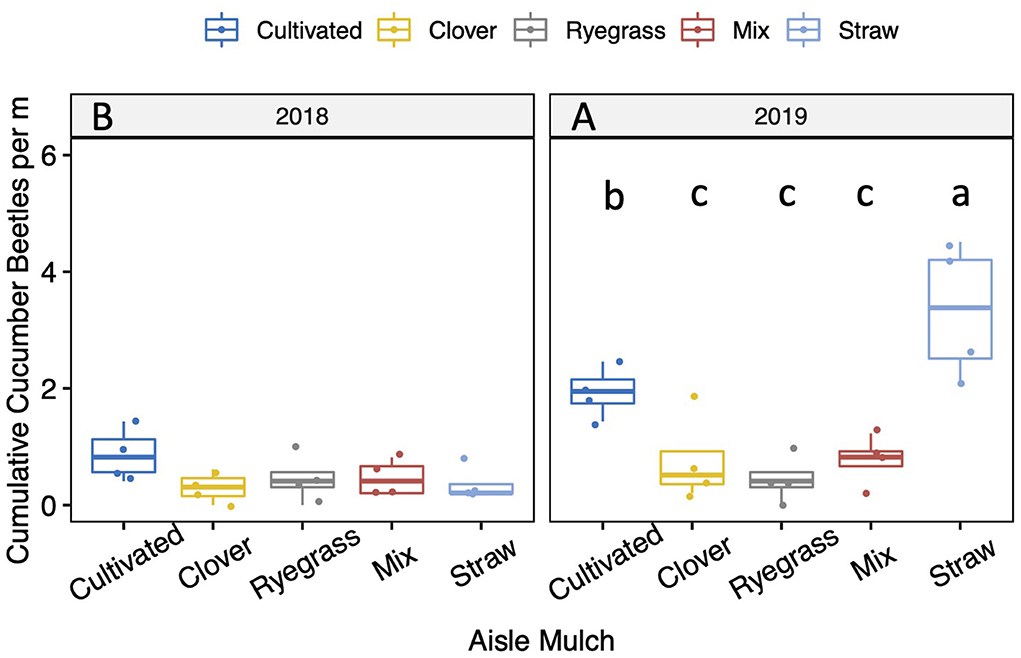
Figure 2. Cumulative cucumber beetles m−1 on organic zucchini plants grown using cover crop living mulches, averaged across 2018 and 2019. Treatments with the same lowercase letter (or no letter) were not significantly different within the same year at p < 0.05, while uppercase letters indicate groupings for year across mulch treatments.
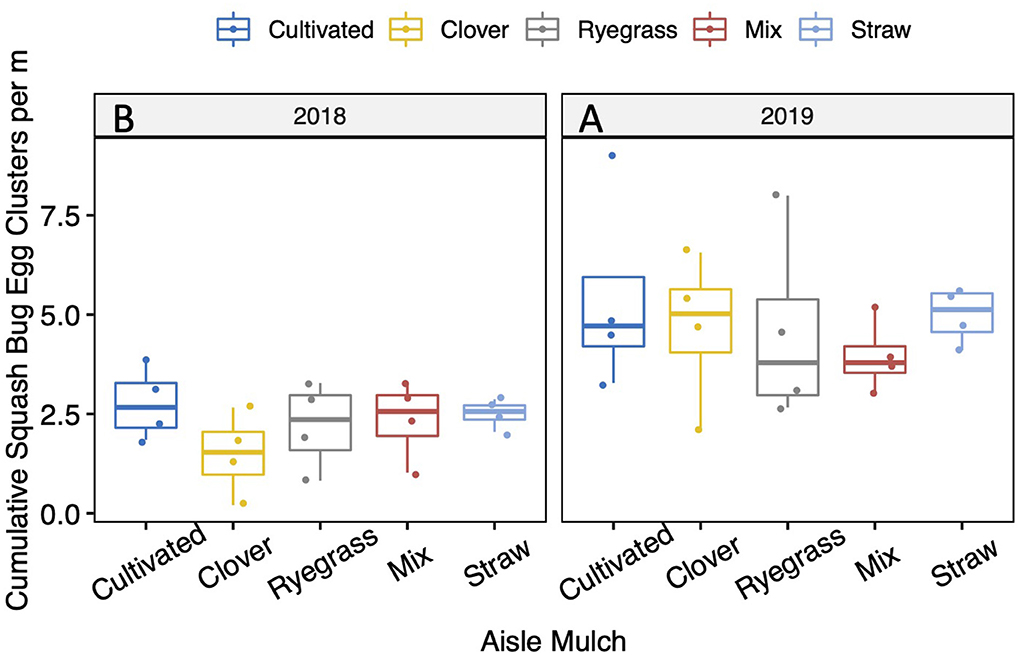
Figure 3. Cumulative squash bug egg clusters m−1 on organic zucchini plants grown using cover crop living mulches, 2018 and 2019.
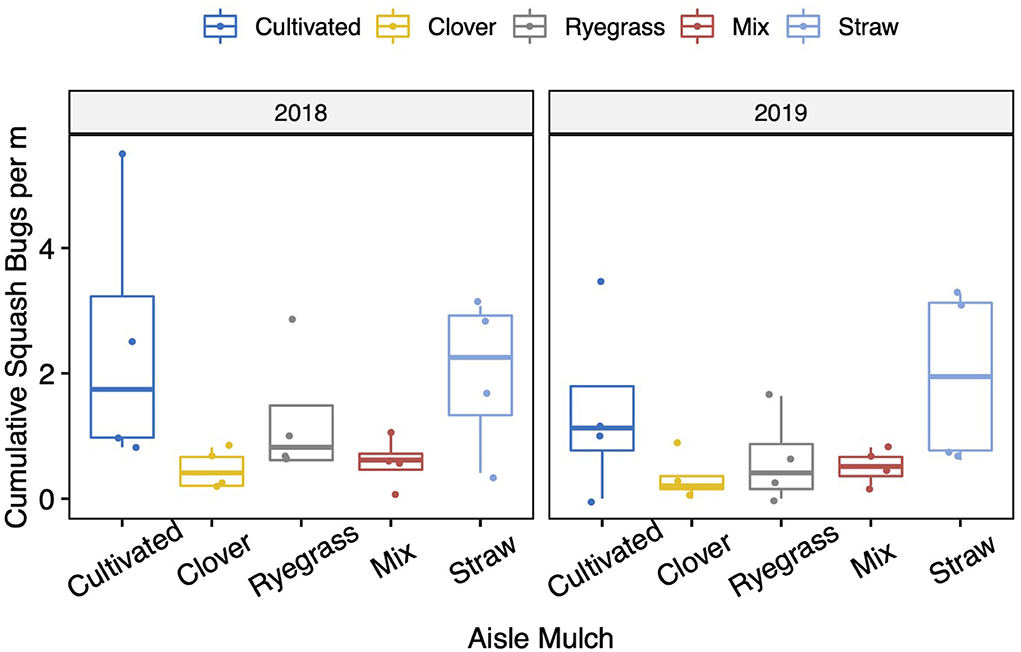
Figure 4. Cumulative squash bugs m−1 on organic zucchini plants grown using cover crop living mulches, 2018 and 2019. There was no interaction between year and aisle mulch, but across both years clover had significantly fewer squash bugs m−1 than cultivated or straw mulched aisles.
A significant year × aisle mulch interaction was observed for living mulch percent cover (Figure 5). Whereas, in 2018 ryegrass had lower coverage than both other living mulch treatments and the mixed species living mulch in turn had lower coverage than the clover treatment, in 2019 only the mixed species had less coverage than the clover treatment, and the ryegrass was not different from either group. Overall, percent cover was lower in 2018 than 2019, and across both years clover clearly had the best soil coverage at 90%, while the mixed species living mulch had lower cover at 79% and ryegrass averaged the lowest coverage at 59%.
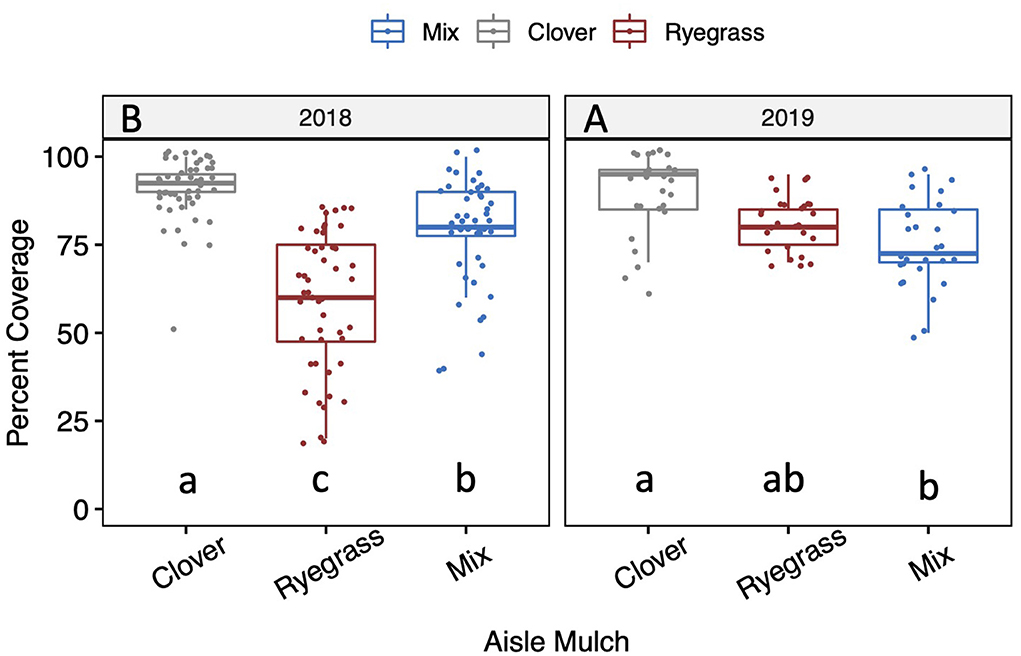
Figure 5. Percent ground cover provided by living mulch treatments, 2018 and 2019. Lowercase letters indicate significance groupings for mulch treatments within a given year, while uppercase letters indicate significance groupings for year across mulch treatments. Treatments that share the same letter are not significantly different at p < 0.05.
A significant year × aisle mulch interaction explained the amount of total, broadleaf, and grass weeds (Figure 6 and Table 5). Across both years, the straw mulch resulted in lower weed counts than other treatments, except for ryegrass for grass weeds, where it performed similarly. For total and grass weeds, the clover resulted in greater weed numbers than all other treatments, and the cultivated treatment resulted in greater weed numbers than ryegrass and mixed species living mulch treatments. Broadleaf weed numbers were similar among all treatments except straw mulch.
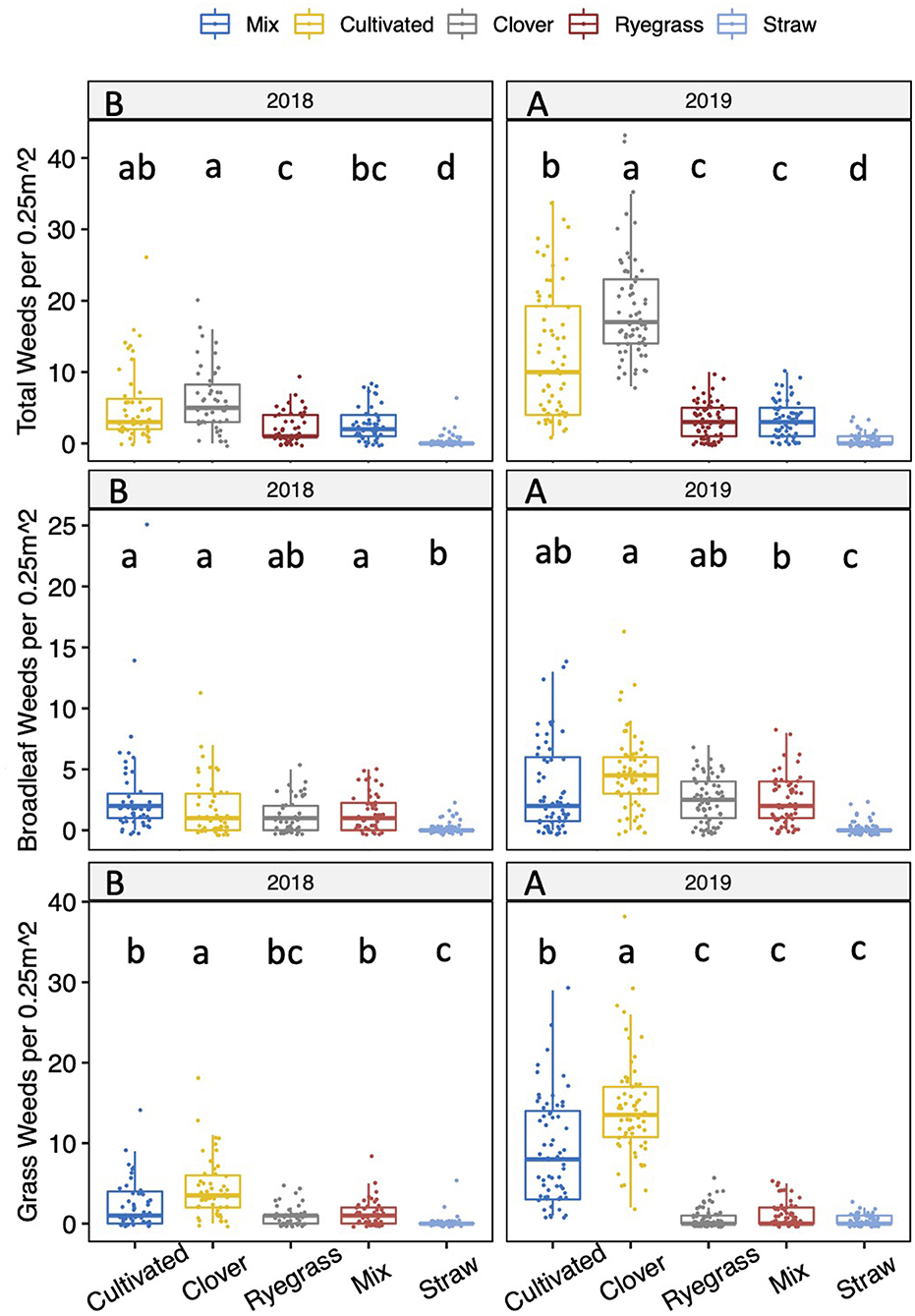
Figure 6. Total (top), broadleaf (center), and grass (bottom) weed counts per 0.25 m2 across dates and subsamples, 2018 and 2019. Lowercase letters indicate significance groupings within a given year and weed response variable, while uppercase letters indicate significance groupings for years across aisle mulch treatments. Groups that share the same letter are not significantly different at p < 0.05.
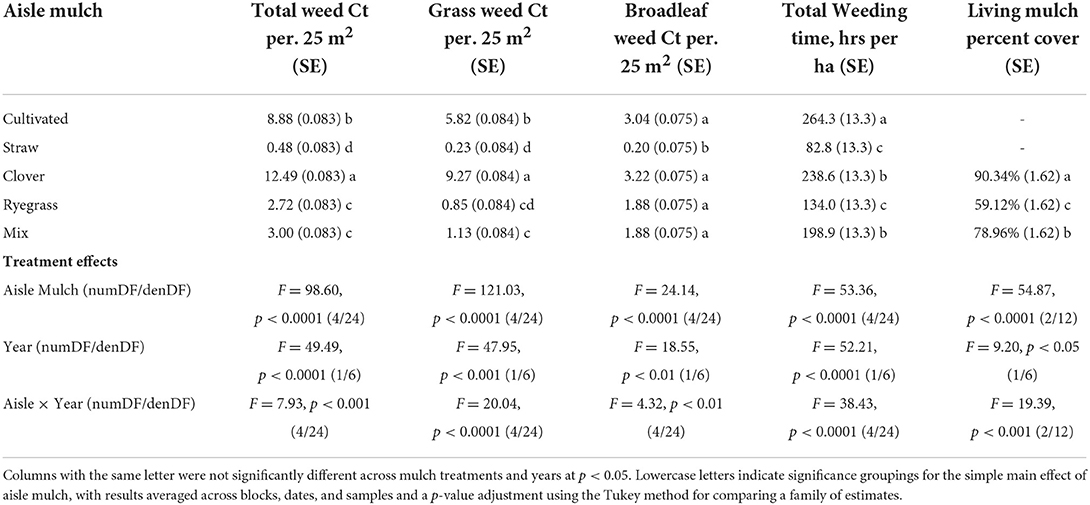
Table 5. Least square means of cumulative weed counts and management required for organic zucchini plots grown using living mulch treatments.
Despite its notably higher weed numbers, the clover treatment required less time for weed management than cultivated aisles. The mixed species living mulch required a similar amount of weed management time as compared to the clover treatment, despite having fewer weeds. Straw mulch and ryegrass required less weed management time than all other groups (Figure 7).
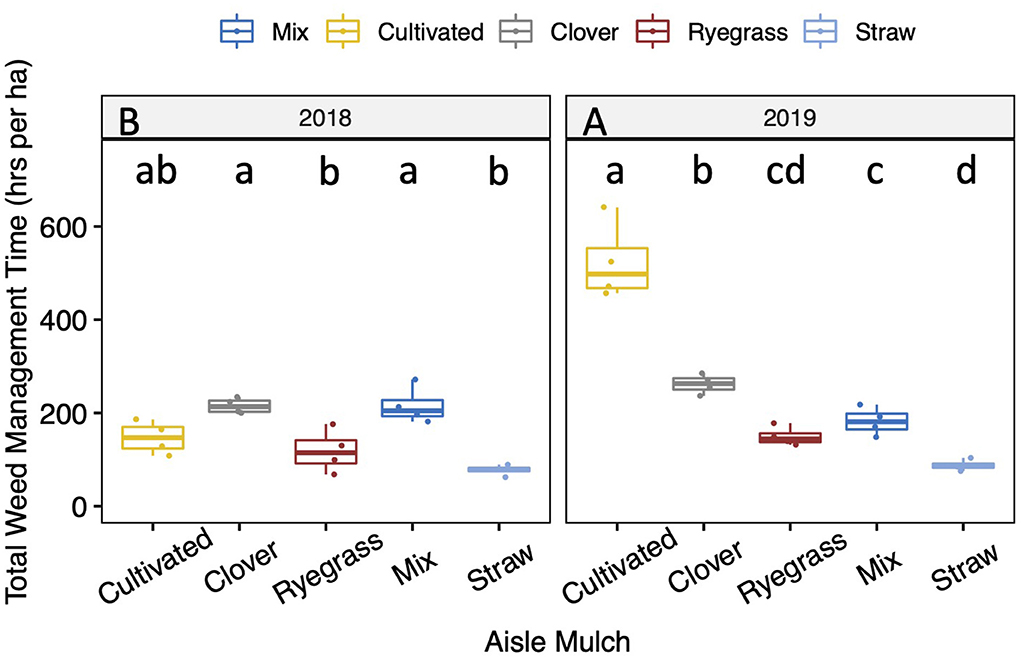
Figure 7. Cumulative weed management time required for each living mulch cover crop treatment, 2018 and 2019. Lowercase letters indicate significance groupings within a given year and weed response variable, while uppercase letters indicate significance groupings for years across aisle mulch treatments. Groups that share the same letter are not significantly different at p < 0.05. Treatments that share the same letter are not significantly different at p < 0.05.
Differences in weed management time relative to the quantity of weeds may have been influenced by different field crews in different years, although during a specific weed management event, the same crew member always weeded the entirety of a given block across treatments.
Previous research demonstrated variable or negative impacts on yield when cucurbit species were produced using living mulch systems (Nyoike and Liburd, 2010; Hinds et al., 2016), although some limited results demonstrated a mitigation of yield losses when plastic mulch was laid within the planting row (Nelson and Gleason, 2018; Kahl et al., 2019).
Our results reinforce the risk of reduced yield in living mulch systems, with lower marketable yield in treatments using clover and annual ryegrass as a living mulch as compared to managing the aisles using cultivation or straw mulch. However, using the mixture of annual ryegrass and clover performed comparably to the more standard management practices of cultivation and straw mulch. Management practices to reduce the potential for competition between cover crops and cash crops, such as the regular mowing of living mulches to a height of 15 cm (Båth et al., 2008; Hinds et al., 2016), and the management of the planting strip using plastic mulch (Nelson and Gleason, 2018), did not fully mitigate reduced yields in our study. While low mowing has the potential to result in reduced competition or mitigate cash crop yield loss (Liu and Huang, 2002; Hinds et al., 2016), future studies could compare mowing with mechanical root pruning, which has also been suggested as a practice to reduce living mulch competition with cash crops (Båth et al., 2008).
Our results supported previous studies suggesting potential benefits of living mulches for reducing pest pressure (Nyoike and Liburd, 2010; Grasswitz, 2013; Kahl et al., 2019). However, our results should be interpreted in the context of relatively low overall pest pressure, apart from early season squash bug pressure in 2019, which was high enough that we chose to apply pyrethrin once in order to ensure enough marketable harvest data. In addition, the relatively small plot size may have introduced more noise due to the mobility of the pests evaluated in this study.
In contrast to Grasswitz's observation that living mulch systems resulted in greater squash bug pressure as compared to standard management, our results showed no clear differences between management approaches for the numbers of squash bug eggs. However, the lower numbers of adults resulting from the use of living mulch cover crops observed in our study could be due to increased natural predators in living mulch systems (Nyoike and Liburd, 2010; Grasswitz, 2013; Kahl et al., 2019), although reduced plant health or N content in living mulch plots could also have caused pests to prefer control treatments (Mauck et al., 2010). Given the prevalence of plastic mulch for producers, future studies could investigate whether the same mechanism of increased predator populations might be responsible for reduced pest pressure in plasticulture systems with living mulch.
Our results also support previous research indicating that clover does not adequately suppress weeds during the establishment year (MacLaren et al., 2019; Tarrant et al., 2020). Soil coverage by the cover crop, a potential indicator of light competition (Place et al., 2011), did not appear to be the significant driver of reduced weed counts in our study, given that clover resulted in a higher percent coverage than ryegrass or the mixed species treatments but still had higher weed counts. The clover treatment also had a consistently lower yield m−1. As compared with the cultivated control, ryegrass reduced weed counts both years, but still yielded fewer marketable fruit. The mixed species performed best out of the living mulch treatments, with weed control comparable to ryegrass and yields equivalent to the cultivated and straw mulch controls.
The use of annual ryegrass and an annual ryegrass/clover mix resulted in better weed suppression as compared to a clover cover crop alone. Results from Tarrant et al. (2020) suggest that both ryegrass and clover have the potential to reduce soil nitrate and moisture within the cash crop row relative to cultivated controls, supporting the negative impacts on yields observed in both treatments in our study. Anecdotally, chlorosis was visible in living mulch treatments in 2019 (Figure 8), suggesting that nutrient competition between cash and cover crops may have contributed to reduced yields. Lower N content in the cash crop grown with living mulches may also have resulted in reduced pest preference for those plants, while on the other hand poor plant health can also reduce tolerance to pests (Magdoff and Van Es, 2000; Altieri and Nicholls, 2003).
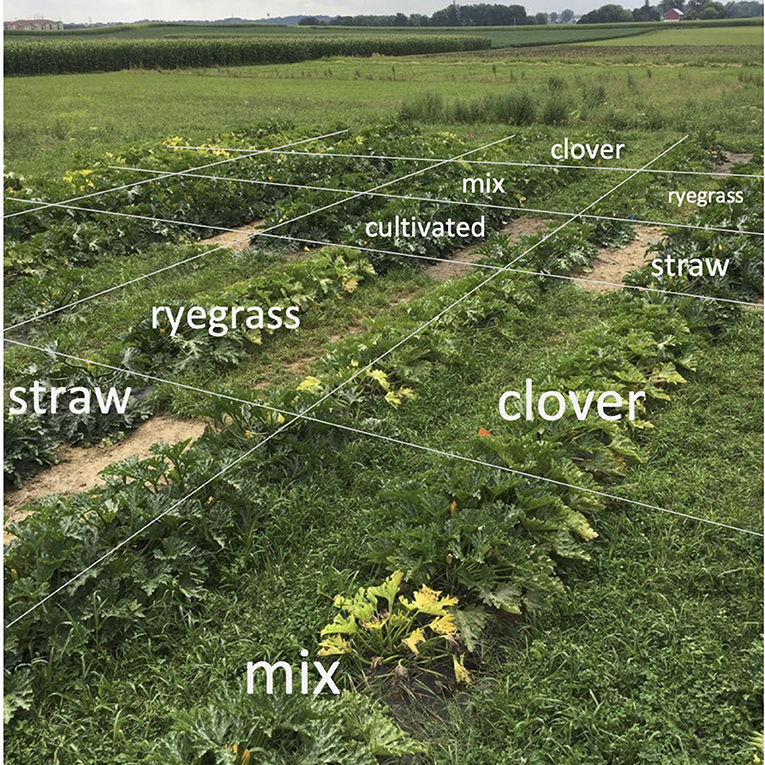
Figure 8. Photograph of organic zucchini plants grown in living mulch treatments, 2019. Note that the particularly stunted and yellowed plant in the foreground mixed species living mulch plot was afflicted with fusarium wilt, whereas in many other living mulch plots the plants were yellowing without any particular disease identifiable as the cause.
Given the equivalent proportions of unmarketable fruit, benefits for pest control, and even comparable weed control in ryegrass as compared to straw mulch, future studies could address the potential of nutrient and water resource competition as a possible driver of reduced marketable fruit yields in living mulch cucurbit systems. Analyzing nutrient and water status of both cash crop and cover crops and testing supplementary fertilizer, such as has been done in other crops (e.g., Fracchiolla et al., 2020 or Warren et al., 2015), may help understand the role of cover crop competition in reducing cash crop yield.
In one of the two years of our study, managing the aisle as bare ground required significantly longer weed management time as compared to managing the aisles using any of the cover crop treatments. Similar to the observation of Butler et al. (2013) that a single mowing event is not adequate to eliminate some weed species' reproductive capacity, the greatest proportion of the weed management time required for living mulch treatments was in additional hand weeding to remove weeds not terminated completely by the mower. Anecdotally, most of the hand weeding required was found outside of the mower management zone, either below the mower deck, or at the shoulders of the bed underneath the more mature cash crop canopy encroaching into the aisle. However, all treatments were weeded completely clean at each weeding event to create equivalent conditions between the living mulch treatments and the bare cultivated control. In a more practical circumstance, farmers may have a higher tolerance for weed pressure, in which case simply mowing the living mulch treatments may suffice.
Clover had higher weed counts than cultivated aisles in 2019, yet required less management time, indicating the use of mowing as a management tool in living mulch treatments likely hindered weed growth, thus contributing to reduced impact of higher weed counts in 2019 as compared with 2018. Despite significantly higher weed counts in 2019 as compared to 2018 across all mulch treatments, only the cultivated treatment took longer for weed management in the second year, whereas straw and living mulches had equivalent management times between years. Our results suggest that alongside traditional organic and plastic mulches, living mulch managed with mowing has potential to mitigate some of the increased management time associated with very weedy conditions, whereas in less weedy conditions they may take longer to manage than traditional options like straw mulch or cultivation.
This study contributes to our further understanding of effects of living mulch on weed and pest pressure, with the system demonstrating potential for agroecosystem benefits but variable impacts on cash crop yield. Further research over multiple years, across multiple environments and with additional crops will contribute to our understanding of the system's performance across organic vegetable farms. While pest pressure was low during both years of our study, production environments experiencing greater pest pressure may benefit more from the use of living mulches. However, to reduce the risk associated with the adoption of these practices, future research should address potential economic and management considerations such as weed management thresholds, supplementary weed management methods. It is also important to investigate the competition potential between cover crops and cash crops, how nutrient status influences pest preference, specific causes of unmarketability, and yield response to supplementary fertilizer.
The raw data supporting the conclusions of this article will be made available by the authors, without undue reservation.
ES: conceptualization and funding application. ES and DB: research design. DB: data collection. DB, ES, and JD: data analysis/interpretation, writing, and editing manuscript. All authors contributed to the article and approved the submitted version.
This work was supported by the United States Department of Agriculture Organic Research and Extension Initiative Grant #2016-51300-25732.
We would like to thank Dr. Zsofia Szendrei of Michigan State University for her leadership on the multi-state project of into which this study was integrated. We would also like to thank Janet Hedtcke and the staff of the West Madison Agricultural Research Station and the Undergrads who helped with the data collection.
The authors declare that the research was conducted in the absence of any commercial or financial relationships that could be construed as a potential conflict of interest.
All claims expressed in this article are solely those of the authors and do not necessarily represent those of their affiliated organizations, or those of the publisher, the editors and the reviewers. Any product that may be evaluated in this article, or claim that may be made by its manufacturer, is not guaranteed or endorsed by the publisher.
The Supplementary Material for this article can be found online at: https://www.frontiersin.org/articles/10.3389/fsufs.2022.995224/full#supplementary-material
Supplementary Figure 1. RCBD layout with four replications. 2019 layout is shown here, while 2018 was similar but randomized differently.
Supplementary Figure 2. Yield of marketable and unmarketable plant−1 of organic zucchini grown using cover crop living mulches, 2018 and 2019. Uppercase letters indicate groupings for year across mulch treatments year at p < 0.05.
Altieri, M. A., and Nicholls, C. I. (2003). Soil fertility management and insect pests: harmonizing soil and plant health in agroecosystems. Soil Tillage Res. 72, 203–211. doi: 10.1016/S0167-1987(03)00089-8
Amirault, J. P., and Caldwell, J. S. (1998). Living mulch strips as habitats for beneficial insects in the production of cucurbits. HortScience 33, 524–525. doi: 10.21273/HORTSCI.33.3.524f
Arnold, G. L., Luckenbach, M. W., and Unger, M. A. (2004). Runoff from tomato cultivation in the estuarine environment: biological effects of farm management practices. J. Exp. Mar. Biol. Ecol. 298, 323–346. doi: 10.1016/S0022-0981(03)00366-6
Båth, B., Kristensen, H. L., and Thorup-Kristensen, K. (2008). Root pruning reduces root competition and increases crop growth in a living mulch cropping system. J. Plant Interact. 3, 211–221. doi: 10.1080/17429140801975161
Baraibar, B., Hunter, M. C., Schipanski, M. E., Hamilton, E., and Mortensen, D. A. (2018). Weed suppression in cover crop monocultures and mixtures. Weed Sci. 66, 121–133. doi: 10.1017/wsc.2017.59
Bezuidenhout, S. R., Reinhardt, C. F., and Whitwell, M. I. (2012). Cover crops of oats, stooling rye and three annual ryegrass cultivars influence maize and Cyperus esculentus growth. Weed Res. 52, 153–160. doi: 10.1111/j.1365-3180.2011.00900.x
Brainard, D. C., Peachey, R. E., Haramoto, E. R., Luna, J. M., and Rangarajan, A. (2013). Weed ecology and nonchemical management under strip-tillage: implications for northern US vegetable cropping systems. Weed Technol. 27, 218–230. doi: 10.1614/WT-D-12-00068.1
Brown, B., and Gallandt, E. R. (2018). A systems comparison of contrasting organic weed management strategies. Weed Sci. 66, 109–120. doi: 10.1017/wsc.2017.34
Brust, J., Claupein, W., and Gerhards, R. (2014). Growth and weed suppression ability of common and new cover crops in Germany. Crop Prot. 63, 1–8. doi: 10.1016/j.cropro.2014.04.022
Butler, R. A., Brouder, S. M., Johnson, W. G., and Gibson, K. D. (2013). Response of four summer annual weed species to mowing frequency and height. Weed Technol. 27, 798–802. doi: 10.1614/WT-D-12-00112.1
Deguchi, S., Uozumi, S., Touno, E., Kaneko, M., and Tawaraya, K. (2012). Arbuscular mycorrhizal colonization increases phosphorus uptake and growth of corn in a white clover living mulch system. Soil Sci. Plant Nutr. 58, 169–172. doi: 10.1080/00380768.2012.662697
Doughty, H. B., Wilson, J. M., Schultz, P. B., and Kuhar, T. P. (2016). Squash bug (Hemiptera: Coreidae): biology and management in cucurbitaceous crops. J. Integr. Pest Manag. 7, 1. doi: 10.1093/jipm/pmv024
Fracchiolla, M., Renna, M., D'Imperio, M., Lasorella, C., Santamaria, P., and Cazzato, E. (2020). Living mulch and organic fertilization to improve weed management, yield and quality of broccoli raab in organic farming. Plants 9, 177. doi: 10.3390/plants9020177
Grasswitz, T. R. (2013). Development of an insectary plant mixture for New Mexico and its effect on pests and beneficial insects associated with pumpkins. Southwest. Entomol. 38, 417–436. doi: 10.3958/059.038.0306
Haber, A. I., Wallingford, A. K., Grettenberger, I. M., Ramirez Bonilla, J. P., Vinchesi-Vahl, A. C., and Weber, D. C. (2021). Striped cucumber beetle and western striped cucumber beetle (Coleoptera: Chrysomelidae). J. Integr. Pest Manag. 12, 1. doi: 10.1093/jipm/pmaa026
Hartwig, N. L., and Ammon, H. U. (2002). Cover crops and living mulches. Weed Sci. 50, 688–699. doi: 10.1614/0043-1745(2002)050[0688:AIACCA]2.0.CO;2
Hiltbrunner, J., Jeanneret, P., Liedgens, M., Stamp, P., and Streit, B. (2007). Response of weed communities to legume living mulches in winter wheat. J. Agron. Crop Sci. 193, 93–102. doi: 10.1111/j.1439-037X.2007.00250.x
Hinds, J., Wang, K. H., and Hooks, C. R. (2016). Growth and yield of zucchini squash (Cucurbita pepo L.) as influenced by a sunn hemp living mulch. Biol. Agric. Hortic. 32, 21–33. doi: 10.1080/01448765.2015.1017736
Jabbour, R., Pisani-Gareau, T., Smith, R. G., Mullen, C., and Barbercheck, M. (2016). Cover crop and tillage intensities alter ground-dwelling arthropod communities during the transition to organic production. Renew. Agric. Food Syst. 31, 361–374. doi: 10.1017/S1742170515000290
Jenkins, D., and Ory, J. (2016). National Organic Research Agenda. Organic Farming Research Foundation. Santa Cruz CA.
Kahl, H. M., Leslie, A. W., and Hooks, C. R. (2019). Effects of red clover living mulch on arthropod herbivores and natural enemies, and cucumber yield. Ann. Entomol. Soc. Am. 112, 356–364. doi: 10.1093/aesa/say036
Kasirajan, S., and Ngouajio, M. (2012). Polyethylene and biodegradable mulches for agricultural applications: a review. Agron. Sustain. Dev. 32, 501–529. doi: 10.1007/s13593-011-0068-3
Laboski, C. A. M., and Peters, J. B. (2019). Nutrient Application Guidelines for Field, Vegetable, and Fruit Crops in WI. A2809. University of Wisconsin Cooperative Extension.
Law, D. M., Rowell, A. B., Snyder, J. C., and Williams, M. A. (2006). Weed control efficacy of organic mulches in two organically managed bell pepper production systems. HortTechnology 16, 225–232. doi: 10.21273/HORTTECH.16.2.0225
Lenth, R. V. (2022). Emmeans: Estimated Marginal Means, aka Least-Squares Means. R package version 1.7.2. Available online at: https://CRAN.R-project.org/package=emmeans
Liebman, M., Gallandt, E. R., and Jackson, L. E. (1997). Many little hammers: ecological management of crop-weed interactions. Ecol. Agric. 1, 291–343. doi: 10.1016/B978-012378260-1/50010-5
Liu, X., and Huang, B. (2002). Mowing effects on root production, growth, and mortality of creeping bentgrass. Crop Sci. 42, 1241–1250. doi: 10.2135/cropsci2002.1241
MacLaren, C., Swanepoel, P., Bennett, J., Wright, J., and Dehnen-Schmutz, K. (2019). Cover crop biomass production is more important than diversity for weed suppression. Crop Sci. 59, 733–748. doi: 10.2135/cropsci2018.05.0329
Magdoff, F., and Van Es, H. (2000). Building Soils for Better Crops (No. 631.584/M188b). Beltsville: Sustainable Agriculture Network.
Mauck, K. E., De Moraes, C., and Mescher, M. C. (2010). Deceptive chemical signals induced by a plant virus attract insect vectors to inferior hosts. Proc. Natl. Acad. Sci. U.S.A. 107, 3600–3605. doi: 10.1073/pnas.0907191107
Moynihan, M. (2010). Status of Organic Agriculture in Minnesota. Available online at: https://www.leg.mn.gov/docs/2010/mandated/100851.pdf (accessed July 4, 2022).
MRCC (2021). Daily precipitation and temperatures – UW-Madison Arboretum Station. Midwestern Regional Climate Center (accessed July 4, 2022).
Nelson, H., and Gleason, M. (2018). Comparing between-row mulches in organic muskmelon and squash-year 2. 2017 Farm Progress Rep. 19–21. Available online at: https://dr.lib.iastate.edu/server/api/core/bitstreams/34683d4b-2588-4423-89a3-b69a25cc1034/content
Nyoike, T. W., and Liburd, O. E. (2010). Effect of living (buckwheat) and UV reflective mulches with and without imidacloprid on whiteflies, aphids and marketable yields of zucchini squash. Int. J. Pest Manag. 56, 31–39. doi: 10.1080/09670870902991815
Pfeiffer, A., Silva, E., and Colquhoun, J. (2016). Living mulch cover crops for weed control in small-scale applications. Renew. Agric. Food Syst. 31, 309–317. doi: 10.1017/S.1742170515000253
Pinheiro, J., Bates, D., and R Core Team. (2022). nlme: Linear and Nonlinear Mixed Effects Models. R package version 3.1-157. Available online at: https://CRAN.R-project.org/package=nlme
Place, G. T., Reberg-Horton, S. C., Dickey, D. A., and Carter, T. E. Jr. (2011). Identifying soybean traits of interest for weed competition. Crop Sci. 51, 2642–2654. doi: 10.2135/cropsci2010.11.0654
R Core Team (2022). R: A Language and Environment for Statistical Computing. R Foundation for Statistical Computing, Vienna, Austria. Available online at: https://www.R-project.org/
R Foundation for Statistical Computing (2021). R: A Language and Environment for Statistical Computing. R Foundation for Statistical Computing, Vienna, Austria. Available online at: https://www.R-project.org/ (accessed July 4, 2022).
Reid, J., and Klotzbach, K. (2013). 2013 Final Report for ONE12-171. Available online at: https://projects.sare.org/project-reports/one12-171/ (accessed July 4, 2022).
Rice, P. J., Harman-Fetcho, J. A., Teasdale, J. R., Sadeghi, A. M., McConnell, L. L., Coffman, C. B., et al. (2004). Use of vegetative furrows to mitigate copper loads and soil loss in runoff from polyethylene (plastic) mulch vegetable production systems. Environ. Toxicol. Chem. Int. J. 23, 719–725. doi: 10.1897/03-14
Sarrantonio, M. (1992). Opportunities and challenges for the inclusion of soil-improving crops in vegetable production systems. HortScience 27, 754–758. doi: 10.21273/HORTSCI.27.7.754
Sarrantonio, M., and Gallandt, E. (2003). The role of cover crops in North American cropping systems. J. Crop Prod. 8, 53–74. doi: 10.1300/J144v08n01_04
Snapp, S. S., Swinton, S. M., Labarta, R., Mutch, D., Black, J. R., Leep, R., et al. (2005). Evaluating cover crops for benefits, costs, and performance within cropping system niches. Agron. J. 97, 322–332. doi: 10.2134/agronj2005.0322a
Sportelli, M., Frasconi, C., Fontanelli, M., Pirchio, M., Gagliardi, L., Raffaelli, M., et al. (2022). Innovative living mulch management strategies for organic conservation field vegetables: evaluation of continuous mowing, flaming, and tillage performances. Agronomy 12, 622. doi: 10.3390/agronomy12030622
Steinmetz, Z., Wollmann, C., Schaefer, M., Buchmann, C., David, J., Tröger, J., et al. (2016). Plastic mulching in agriculture. Trading short-term agronomic benefits for long-term soil degradation? Sci. Total Environ. 550, 690–705. doi: 10.1016/j.scitotenv.2016.01.153
Tarrant, A. R., Brainard, D. C., and Hayden, Z. D. (2020). Cover crop performance between plastic-mulched beds: impacts on weeds and soil resources. HortScience 55, 1069–1077. doi: 10.21273/HORTSCI14956-20
Teasdale, J. R., and Mohler, C. L. (2000). The quantitative relationship between weed emergence and the physical properties of mulches. Weed Sci. 48, 385–392. doi: 10.1614/0043-1745(2000)048[0385:TQRBWE]2.0.CO;2
Teasdale, J. R., Rice, C. P., Cai, G., and Mangum, R. W. (2012). Expression of allelopathy in the soil environment: soil concentration and activity of benzoxazinoid compounds released by rye cover crop residue. Plant Ecol. 213, 1893–1905. doi: 10.1007/s11258-012-0057-x
USDA-NASS (2019). 2019 Organic Survey (2017) Census of Agriculture Special Report. United States Department of Agriculture – National Agricultural Statistics Service. Available online at: https://www.nass.usda.gov/Surveys/Guide_to_NASS_Surveys/Organic_Production/ (accessed July 4, 2022).
Walters, S. A., Soloneski, S., and Larramendy, M. L. (2011). Weed Management Systems for No-Tillage Vegetable Production. Herbicides, theory and applications.
Warren, N. D., Smith, R. G., and Sideman, R. G. (2015). Effects of living mulch and fertilizer on the performance of broccoli in plasticulture. HortScience 50, 218–224 doi: 10.21273/HORTSCI.50.2.218
Keywords: organic agriculture, cover crops, squash, weed management, continuous living cover
Citation: Bruce D, Silva EM and Dawson JC (2022) Suppression of weed and insect populations by living cover crop mulches in organic squash production. Front. Sustain. Food Syst. 6:995224. doi: 10.3389/fsufs.2022.995224
Received: 15 July 2022; Accepted: 31 August 2022;
Published: 06 October 2022.
Edited by:
Ashley Conway, University of Missouri, United StatesReviewed by:
Tom Bilbo, Clemson University, United StatesCopyright © 2022 Bruce, Silva and Dawson. This is an open-access article distributed under the terms of the Creative Commons Attribution License (CC BY). The use, distribution or reproduction in other forums is permitted, provided the original author(s) and the copyright owner(s) are credited and that the original publication in this journal is cited, in accordance with accepted academic practice. No use, distribution or reproduction is permitted which does not comply with these terms.
*Correspondence: Erin M. Silva, ZW1zaWx2YUB3aXNjLmVkdQ==
Disclaimer: All claims expressed in this article are solely those of the authors and do not necessarily represent those of their affiliated organizations, or those of the publisher, the editors and the reviewers. Any product that may be evaluated in this article or claim that may be made by its manufacturer is not guaranteed or endorsed by the publisher.
Research integrity at Frontiers

Learn more about the work of our research integrity team to safeguard the quality of each article we publish.